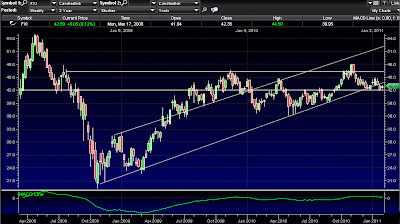Lately I've been doing more writing and have been highlighting the battle that is being waged in the economy. In my recent article Inflation Bombs, I discussed how the US central bank was using dollar devaluation to inflate assets (stocks and commodities). The next major post highlighted the Japanese experience with deflation in Why Aren't We Turning Japanese.
The key takeaway in these posts is that our US FED has opted to inflate assets and the by-product of that choice is a flood of speculative dollars deployed throughout the world. The result of the deluge has been massive increases in commodity prices, tougher living conditions for the poor and retired, and an increase cost of living for US and world citizens.
I received a few comments from a reader the other day and the basic thrust of his comments were that China and the emerging economies were an easy choice for us to make when compared to the recessionary economy of the US. While there is part of me that agrees with him fully we need to make a distinction between "economy" and stock or commodity investing targets (of course time frame is important too). My statement is made clear as we examine the chart below and see that the FXI has dropped some 11% from it's recent highs in November.
FUNDAMENTAL VIEW
From a fundamental long term perspective I think the reader has the correct investment thesis (of course I like it because I've had it and traded on it for the last 18 months!). However, the short-term in China has me taking a pause because the charts are telling me that we are at an inflection point. We'll talk about those technical trading markers in a second. First though, I'll put China in the same basket as all the other emergings that I like.
POSITIVES
Relative Low Employment Costs (to Europe or the US)
Little Environmental Protection Regulation
Excellent Demographics (Growing Middle Class)
Fast Growing Economy
NEGATIVESQuestionable Rule of Law (Legal Rights and Copy-Right enforcement)
Closed markets to foreign firms
Inflation (Wages)
Inflation (Land)
Inflation (Raw Materials)
Inflation (Food)
If you are getting the point that I'm most concerned about inflation in the emerging world, you'd be right. We don't need to look further than Tunisia, Egypt, Jordan, Yemen and Oman to see that poor, unemployed, youth ultimately rise up and look to change the leadership and rules of the land. The food inflation and poor employment may have been the final straw that broke that cause the Tunisians and Egyptians to revolt, but these are real issues that we must examine in our favorite countries like Singapore, Malaysia, South Korea, Taiwan, Thailand, Chile, India, and Indonesia. To clarify, I tend to think that China is further along in its emergence than the others that I've listed, and in fact is now had such an improvement that it is losing manufacturing business to the other Tigers because wage costs are increasing in the mainland.
I think the story I found here describes the wage situation in China quite well.
- http://business.globaltimes.cn/china-economy/2011-01/617201.html
The story describes a situation where living costs are now growing at such a clip that workers are simply walking out of their jobs and not returning from their Chinese New Year holiday since wages are not enough to pay their living expenses. The impact of this is that manufacturers are being forced to delay shipments to the world (for useless junk we don't need). This means that US retailers can't get the products that they have ordered. Finally, the Chinese government is attempting to force wages up with regulations requiring minimum greater minimum wages. In time, this will help and will create a huge domestic economy --- the economy all of the US multi-nationals have all been dreaming of for the last 20 years (remember Dell salivating about making manufacturing plants in China in the late 90's). This future huge economy is what I've discussed for a while as the reason for investing in the emerging markets. I've said it a few times, there will be really big draw downs, but in 20 years we'll be giving each other high fives for investing in these gems.
OK, THAT'S A GREAT LONG TERM VIEW, BUT WHAT ABOUT NOW? - TECHNICAL TRADING UPDATE
Take a look at the two charts above, but let's start with the the colorful black one right above this section. What we see here is that FXI has pretty significant support at $42 and overhead resistance at $47. The biggest concern we have is the lower channel trend line that was recently broken last week. This action to me spells further weakness. If the $42 area of support breaks FXI could easily trade down to $36 ---- (another 15% or 20% from here).
Finally, examine the upper chart. I use this chart to examine the 14 day EMA and the 40 day EMA on a weekly chart. Typically when we see the breakthrough of the 14 day EMA below the 40 day EMA it is a harbinger of doom! (ok, that may be a bit dramatic, but it isn't a positive). For me, when this signal appears it signal is a longer term sign that the trend has turned negative. Let me be clear, it has not crossed below yet, but when it does, it may be a great opportunity to short. I've posted many articles about this signal in the past, one of the best has been VLO where it signaled a positive move up when the stock was in the $18 - $19 area in November 2010. That signal (along with good fundamentals) has proved to be an awesome long term trade.
Keep watching, but with continued inflationary forces bruising the Chinese economy along with a confirmation of the 14 day EMA/40 day EMA crossover, I'd be inclined to trade this.
Wednesday, February 2, 2011
Subscribe to:
Comments (Atom)





